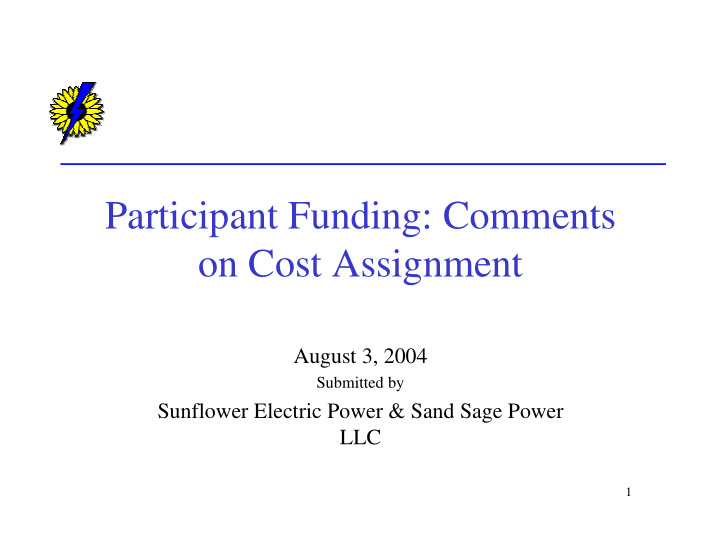



Participant Funding: Comments on Cost Assignment August 3, 2004 Submitted by Sunflower Electric Power & Sand Sage Power LLC 1
Outline • Re-cap of principles and objectives • Difficulty of determining regional vs. local benefits of transmission facilities – new and existing • Proposed allocation and pros and cons • Examples and support for proposed allocation 2
Principles & Objectives • RSC Principles in brief: – Cost causers pay; but not more than benefits – No free riders, no discrimination – Build a reliable system and recover costs – Economic benefit projects allocated to beneficiaries – Send correct price signals for generation location – Encourage competitive supply – Be able to make economics-driven upgrades – Funder retains rights to revenue recovery for capacity paid for ( and may retain transmission capacity rights). • Other objectives: – No shocks to rates or operations – System that is not burdensome or costly to administer, e.g. does not result in extensive litigation or delay that thwarts needed construction. 3
Determination of regional vs. local benefits of transmission facilities is difficult • Character of systems varies widely: – Relatively self-sufficient systems e.g. SPS – Highly intertwined systems e.g PSO and OG&E • Reliability “n-1” benefit of use of regional system is important for every TO and not always apparent in normal flows. • System, as a whole, is highly loaded (see the long list of ‘base case’ thermal and voltage overloads to be fixed), so that even investments that change flows slightly on constrained facilities in neighboring systems are a benefit to those neighbors in postponing reliability investment. • Technical obstacles and uncertainties to determining project-specific benefits are serious, e.g what to assume about locations of new generators? • All the above argues for some regional sharing of costs but lack of strong evidence for which slant is best. 4
A Proposed allocation • Given difficulty of determining “actual benefits”, we propose a 50:50 cost split for all types of new facilities over 100 kV between all customers and the requesting transmission customer. • Regional portion paid uniformly by all SPP customers. • Exception: Generator interconnection is presumed to be 100% participant but could apply to demonstrate regional benefit (as in New England). • Similar split of 50:50 for existing facilities (could get like results for existing facilities by highway/byway ‘functional’ assignment of high voltage to regional rate as Xcel has proposed). What’s magic about 50:50? If you have little or no information about whether 0% or 100% is the right answer, 50% is the correct best guess. 5
Allocation Pros and Cons • Pro: – Provides rough representation, on average, of benefit to causers and beneficiaries. – Provides price signal & discipline for customer decisions. – Simple and inexpensive to administer and decisions can be rapid. – Could be used as transition to more complex process. • Con: – Will miss-allocate costs every time to some extent. – Requires a mechanism for rate recovery by TO’s of regional portion of charge. 6
Case 1: Four Connected, Self- Sufficient TO’s •System intact 90% internal, TO 1 TO 2 10% ‘around the loop’. •Generator out: 100% of Generator flow is ‘regional’. Load of owned by TO 2 •Generator-to-load line out: TO 1 15% of lines used to import, 85% used to export around the loop. •Conclusion: For reliability each TO must use all the rest of network. TO 3 TO 4 “Internal’ means from generator and over line owned by TO to that TO’s load. “Regional’ 7 means flow over one TO’s line from a foreign generator or to serve another TO’s load.
N-1 Case – Generator Out TO 1 TO 2 Generator out: 100% of flow in TO 1 area is Generator Load of owned by ‘regional’ TO 2 TO 1 TO 3 TO 4 8
N-1 Case: TO-1 Line Out TO 1 TO 2 Line out: 100% of flow in TO 1 area is ‘regional’ Generator Load of owned by TO 2 TO 1 TO 3 TO 4 9
Case 2: “Jeffrey” Case – Regional Generation Resource TO 1 TO 2 • System intact: 75% flow is internal • Line out: 50% of flow is ‘regional’ •Conclusion: For line-out reliability, TO must use all the rest of network. TO 3 TO 4 10
Western SPP Example 11
Recommend
More recommend